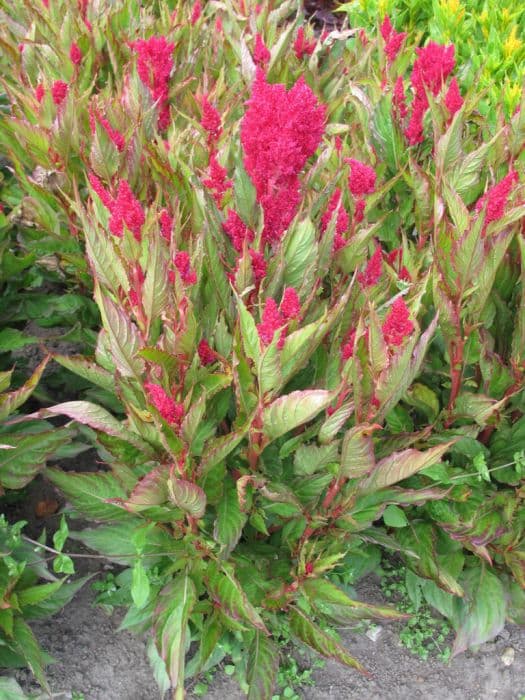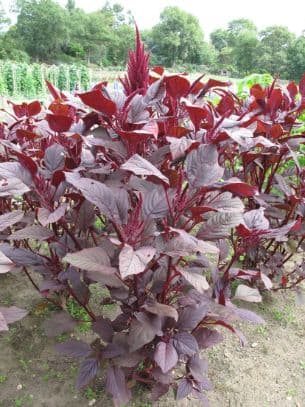Cockscomb Celosia argentea var. cristata (Plumosa Group) 'Century Rose' (Century Series)

ABOUT
Celosia 'Century Rose', part of the Century Series, is a unique and eye-catching plant known for its vibrant pink, plume-like flowers that resemble flames or coral structures. The blooms are dense and feathery, providing a rich texture and making them a popular choice for gardens aiming for a splash of color. These flowers sit atop green, leafy stems, which are sturdy and upright. This variety is recognized for its distinct flower heads that offer an ornamental quality, infusing the landscape with a lively rose-hued presence. As part of the Plumosa Group, it has foliage that is typically green and lance-shaped, contributing to the plant's overall lush appearance. The colorful plumes add a whimsical and tropical feel to any setting where they're planted, making them fantastic for cut flower arrangements as well.
About this plant
 Names
NamesFamily
Amaranthaceae
Synonyms
Cockscomb, Crested Celosia, Woolflower, Brain Celosia
Common names
Celosia argentea var. cristata, Celosia cristata, Celosia plumosa.
 Toxicity
ToxicityTo humans
The Cock's Comb is generally considered non-toxic to humans, and there are no well-documented cases of poisoning from ingesting this plant. Therefore, eating or handling this plant typically does not result in harmful consequences for humans.
To pets
Cock's Comb is also generally recognized as non-toxic to pets. There is no evidence to suggest that ingestion of any part of this plant by household animals like cats and dogs leads to poisoning. Thus, pets should not experience any adverse symptoms upon consuming this plant.
 Characteristics
CharacteristicsLife cycle
Annuals
Foliage type
Deciduous
Color of leaves
Green
Flower color
Pink
Height
1 foot (0.3 meters)
Spread
1 foot (0.3 meters)
Plant type
Herb
Hardiness zones
9
Native area
Africa
Benefits
 General Benefits
General Benefits- Aesthetic Appeal: The vibrant pinkish-red plumes of Celosia cristata 'Century Rose' add striking color and texture to gardens and landscapes.
- Ease of Care: Known for being low maintenance, it is a good choice for gardeners of all skill levels.
- Drought Tolerance: Once established, Celosia has good tolerance to drought, reducing the need for frequent watering.
- Heat Resistance: This plant thrives in hot conditions, making it ideal for warm climates or summer gardens.
- Long Blooming: It offers extended bloom periods, providing colorful interest throughout the growing season.
- Versatility: Suitable for beds, borders, and containers, giving gardeners flexibility in design and space uses.
- Attracts Pollinators: The flowers can attract butterflies and other beneficial pollinators to the garden, supporting biodiversity.
- Edible: The leaves of Celosia can be eaten, often used in African and Asian cuisines, although this variety is primarily ornamental.
- Cut Flowers: Sturdy and long-lasting blooms are excellent for fresh floral arrangements, adding pops of color indoors.
- Dried Flowers: Blooms can be dried and used in arrangements or crafts, retaining their shape and color well after drying.
 Medical Properties
Medical Properties- Anti-inflammatory: Celosia argentea may exhibit anti-inflammatory properties that could help in reducing inflammation.
- Antioxidant: The plant contains components that can act as antioxidants, potentially protecting cells from damage by free radicals.
- Diuretic: It is believed to have diuretic effects, which can help in flushing out excess fluids from the body.
- Wound healing: There are claims that the plant could be used to facilitate the healing of wounds due to its possible astringent properties.
- Eyesight improvement: In traditional medicine, it has been used to address eye-related conditions, although scientific evidence for this use is lacking.
- Hemostatic: The plant may have blood-clotting properties, which could help to control bleeding.
 Air-purifying Qualities
Air-purifying QualitiesThis plant is not specifically known for air purifying qualities.
 Other Uses
Other Uses- The vibrant plumes of the cockscomb can be used as a natural dye for textiles; the deep pink and red hues can be extracted and transferred to fabrics.
- The dried flowers of the cockscomb can serve as a component in potpourri mixes, offering both color and a subtle, grassy scent.
- Cockscomb can be incorporated into scrapbooking and other paper crafts for a touch of natural beauty and three-dimensional texture.
- Its unique shape and texture make it a popular choice for use in dried floral arrangements, adding visual interest and a longer lifespan to the display.
- Cockscomb flowers are sometimes used in edible landscaping, providing a dual purpose of ornamentation while the leaves are used in salads.
- The striking flowers of the cockscomb can be used as a natural indicator for humidity, as they tend to close slightly in high humidity.
- Gardeners can use cockscomb as a companion plant in vegetable gardens, as it can help deter certain pests due to its bright color and shape.
- Culinary artists occasionally use the vibrant flowers as garnishes on dishes and desserts, taking advantage of their bold color and unique appearance.
- The feathery texture and patterns of the cockscomb can inspire artists and designers, who may use the plant as a living muse for textiles, patterns, or artwork.
- Cockscomb can be included in educational activities for children, teaching them about plant biology and the lifecycle of annual flowers through hands-on experience.
Interesting Facts
 Feng Shui
Feng ShuiThe Celosia is not used in Feng Shui practice.
 Zodiac Sign Compitability
Zodiac Sign CompitabilityThe Celosia is not used in astrology practice.
 Plant Symbolism
Plant Symbolism- Affection: As a member of the cock's comb family, Celosia 'Century Rose' often symbolizes warmth and affection due to its vibrant and playful appearance, which can evoke feelings of fondness and endearment.
- Amazement and Admiration: The unique and striking shape of its crested flowers can represent a sense of wonder and admiration, as they appear different from traditional flower forms.
- Singularity: With its unusual and distinctive flower form, Celosia 'Century Rose' can symbolize singularity or standing out from the crowd, reflecting individuality and uniqueness.
- Audacity: The bold colors and patterns of the Celosia 'Century Rose' can be associated with audacity and courage, often encouraging one to be daring and to take risks.
- Invincibility: With its name, Celosia, derived from the Greek word 'kelos', meaning burned or flaming, this plant can symbolize an invincible spirit that is difficult to extinguish or a passion that burns strongly.
 Water
WaterCock's comb should be watered thoroughly, allowing the top inch of soil to dry out between waterings, which typically means watering once every one to two weeks, depending on the climate and indoor conditions. It is preferable to use the bottom-watering method where the pot is placed in a tray of water, allowing the plant to absorb moisture from below. The amount of water will vary, but aim for about 16 ounces every two weeks during active growth periods; adjust based on the plant size and environmental factors to prevent waterlogging.
 Light
LightCock's comb thrives in full sun to partial shade conditions. For best growth and flowering, place the plant in a location where it can receive at least six hours of direct sunlight daily. An east or west-facing window or a spot that receives consistent, bright indirect light throughout the day is also suitable for this sun-loving plant.
 Temperature
TemperatureThe temperature range suitable for Cock's comb varies from a minimum of about 60 degrees Fahrenheit to a high of around 80 degrees Fahrenheit for optimal growth. These plants can survive at temperatures as low as 40 degrees Fahrenheit but will not thrive. The ideal temperature for robust growth and flowering is between 65 and 75 degrees Fahrenheit, with higher temperatures promoting better blooms during the summer.
 Pruning
PruningCock's comb should be pruned to remove faded flowers and encourage further blooming. This deadheading can be done throughout the growing season as necessary. Additionally, cut back any spent stems at the end of the blooming season to tidy up the plant. The best time for more substantial pruning is in late winter or early spring, before new growth begins.
 Cleaning
CleaningAs needed
 Soil
SoilThe best soil mix for Cockscomb (Celosia cristata) should be well-draining, fertile, and rich in organic matter. A recommended mix can be prepared with equal parts of peat, perlite, and compost to provide good aeration and nutrients. The soil pH should be slightly acidic to neutral, around 6.0 to 7.0.
 Repotting
RepottingCockscomb plants typically need to be repotted annually. They have a rapid growth rate and can quickly outgrow their containers, so check for root crowding each spring and repot into a larger container if necessary.
 Humidity & Misting
Humidity & MistingCockscomb thrives in moderate to high humidity levels, around 40-70%. In drier conditions, it's beneficial to increase humidity through misting or using a humidifier. Avoid overly dry air, which can lead to leaf damage.
 Suitable locations
Suitable locationsIndoor
Ensure bright light, warmth, and good air circulation for indoor Cockscombs.
Outdoor
Plant in full sun, well-draining soil, and water regularly for outdoor Cockscombs.
Hardiness zone
2-11 USDA
 Life cycle
Life cycleCelosia argentea var. cristata 'Century Series', commonly known as Cockscomb, begins its life cycle when seeds are sown after the threat of frost has passed, typically in spring. The seeds germinate in warm soil within one to two weeks, and seedlings emerge soon after. After several weeks, the seedlings develop true leaves and can be transplanted if started indoors. The plants enter a vegetative growth phase where they focus on developing foliage and branching, eventually leading to the formation of their unique, showy flower heads, or combs, in summer through autumn. Once they reach maturity and flowering is complete, the plants set seeds, which mature as the combs dry out. The life cycle concludes as the plant dies with the onset of cold weather, leaving behind seeds to start the next generation the following spring.
 Propogation
PropogationPropogation time
Spring-Early Summer
Propogation: The most popular method of propagation for Celosia argentea var. cristata, commonly known as cockscomb, is through seed sowing. The ideal time to sow seeds for cockscomb is in late winter to early spring. Seeds should be scattered onto moist, well-drained soil and lightly covered with a thin layer of soil or vermiculite. The trays or pots should then be kept at a temperature of approximately 70°F (21°C) for optimal germination, which typically occurs within 1 to 2 weeks. Once seedlings have developed a couple of true leaves, they can be transplanted to their final growing location, ensuring they are spaced adequately to accommodate their mature size.




